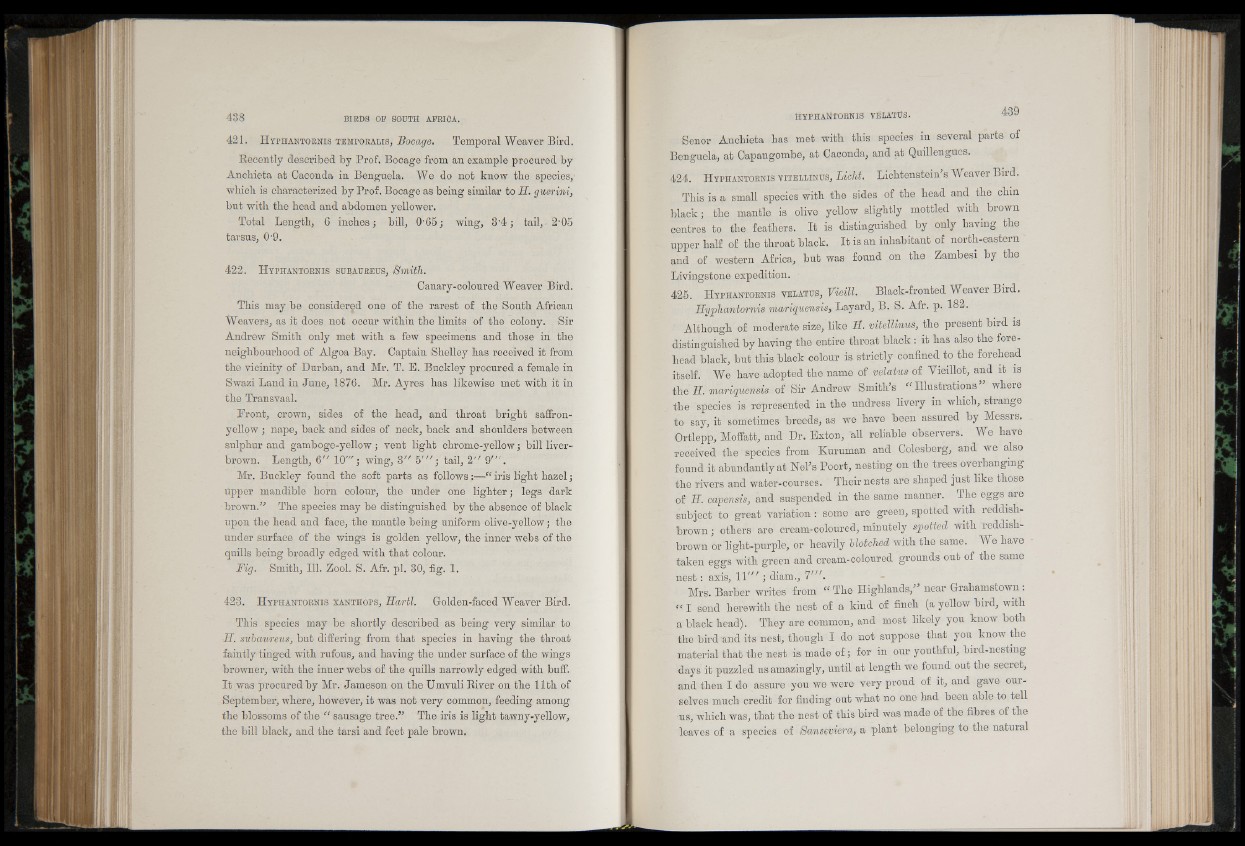
421. H y p h a n t o r n is t em p o r a l is , Bocage. Temporal Weaver Bird.
Recently described by Prof. Booage from an example procured by
Anchieta at Caconda in Benguela. We do not know the species,'
which is characterized by Prof. Bocage as being similar to II. guerini,
but with the head and abdomen yellower.
Total Length, 6 inches; bill, 0-65; wing, 3 '4 ; tail, 2’05
tarsus, 0‘9.
422. H y p h a n t o r n is stjbaureus, Smith.
Canary-coloured Weaver Bird.
This may be considered one of the rarest of the South African
Weavers, as it does not occur within the limits of the colony. Sir
Andrew Smith only met with a few specimens and those in the
neighbourhood of Algoa Bay. Captain Shelley has received it from
the vicinity of Durban, and Mr. T. E. Buckley procured a female in
Swazi Land in June, 1876. Mr. Ayres has likewise met with it in
the Transvaal.
Front, crown, sides of the head, and throat bright saffron-
yellow ; nape, back and sides of neck, back and shoulders between
sulphur and gamboge-yellow; vent light chrome-yellow; bill liver-
brown. Length, 6" 10"'; wing, 3" 5 '" ; tail, 2" 9"'.
Mr. Buckley found the soft parts as follows :—“ iris light hazel;
upper mandible horn colour, the under one lighter; legs dark
brown.” The species may be distinguished by the absence of black
upon the head and face, the mantle being uniform olive-yellow; the
under surface of the wings is golden yellow, the inner webs of the
quills being broadly edged with that colour.
Fig. Smith, 111. Zool. S. Afr. pi. 30, fig. 1.
423. H y p h a n t o r n is x a n t h o p s , Hartl. Golden-faced Weaver Bird.
This species may be shortly described as being very similar to
II. sub aureus, but differing from that species in having the throat
faintly tinged with rufous, and having the under surface of the wings
browner, with the inner webs of the quills narrowly edged with buff.
It was procured by Mr. Jameson on the Umvuli River on the 11th of
September, where, however, it was not very common, feeding among
the blossoms of the “ sausage tree.” The iris is light tawny-yellow,
the bill black, and the tarsi and feet pale brown.
Senor Anchieta has met with this species in several parts of
Benguela, at Capangombe, at Oaconda, and at Quillengues.
424. H y p h a n t o r n is v it e l l in u s , Licht. Lichtenstein’s Weaver Bird.
This is a small species with the sides of the head and the chin
black; the mantle is olive yellow slightly mottled with brown
centres to the feathers. It is distinguished by only having the
upper half of the throat black. It is an inhabitant of north-eastern
and of western Africa, but was found on the Zambesi by the
Livingstone expedition.
425. H y ph a n t o r n is v e l a tu s , Vieill. Black-fronted Weaver Bird.
Hyphantornis mariquensis, Layard, B. S. Afr. p. 182.
Although of moderate size, like H. vitellinus, the present bird is
distinguished by having the entire throat black : it has also the forehead
black, but this black colour is strictly confined to the forehead
itself. We have adopted the name of velatus of Vieillot, and it is
the H. mariquensis -of Sir Andrew Smiths Illustrations where
the species is represented in the undress livery in which, strange
to say, it sometimes breeds, as we have been assured by Messrs.
Ortlepp, Moffatt, and Dr. Exton, all reliable observers. We have
received the species from Kuruman and Colesberg, and we also
found it abundantly at NeTs Poort, nesting on the trees overhanging
the rivers and water-courses. Their nests are shaped just like those
of H. capensis, and suspended in the same manner. The eggs are
subject to great variation: some are green, spotted with reddish-
brown ; others are cream-coloured, minutely spotted with reddish-
brown or light-purple, or heavily blotched with the same. We have
taken eggs with green and cream-coloured grounds out of the same
n e s t: axis, IV " ; diam., 1"'.
Mrs. Barber writes from “ The Highlands,” near Grahamstown:
“ I send herewith the nest of a kind of finch (a yellow bird, with
a black head). They are common, and most likely you know both
the bird'and its nest, though I do not suppose that you know the
material that the nest is made of; for in our youthful, bird-nesting
days it puzzled us amazingly, until at length we found out the secret,
and then I do assure you we were very proud of it, and gave ourselves
much credit for finding out what no one had been able to tell
us, which was, that the nest of this bird was made of the fibres of the
leaves of a species of Sanseviera, a plant belonging to the natural